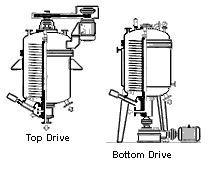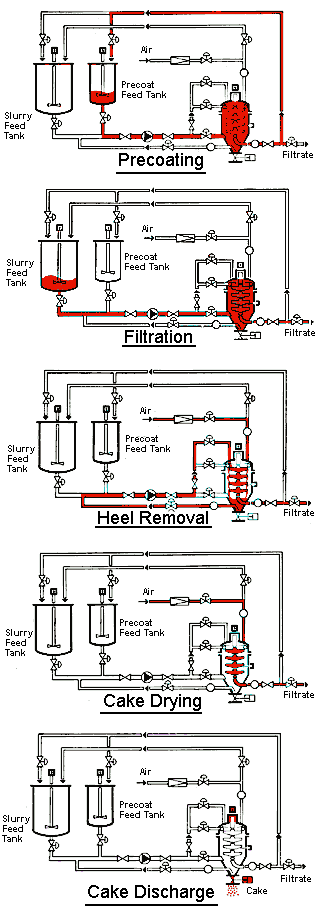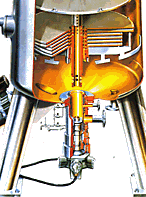|
Click on the
thumbnail to maximize the image |
Horizontal Plate Pressure Filters were commonly applied to the fine chemical process industries such as antibiotics , pesticides or pigments when the load of impure insolubles is low and polishing is required to obtain a high product clarity. However, in recent years they may be seen more and more in heavier industries such as fertilizers or precious metals when the product is the cake and efficient washing and low moistures are required.
|
Horizontal Plate Filters are very well suited for handling flammable, toxic and corrosive materials since they are autoclaved and designed for hazardous environments when high pressure and safe operation are required. Likewise, they may be readily jacketed for applications whenever hot or cold temperatures are to be preserved. These features are not possible on Filterpresses which require the opening of plates to the atmosphere and shifting them one by one to allow cake discharge at the end of each cycle.

The filter structure consists of a stack of plates attached to a hollow shaft which are mounted inside a pressure vessel with each plate covered with a suitable filter medium.
|
The slurry is fed under pressure into the vessel and the cake, which is retained by the filter medium, forms on the top of each plate whilst the filtrate passes through the hollow shaft further to the process. Please refer to the Operational Sequence below which describes the filtration cycle in detail.
Filter sizes may vary but generally the maximum is 60 m2 area and designed for a 6 bar operating pressure.
The Plates
Each circular plate in the stack is constructed with radial ribs that are welded to the bottom and support a horizontal coarse mesh screen which is covered with a finer woven metal screen or filter cloth to retain the cake. The bottom of the plate slopes towards the hollow central shaft which lets the filtrate flow freely through circumferential holes and further down the shaft to the filtrate outlet.
The clearance between the plates is maintained by special spacers with "o" rings to positively seal between the slurry that surrounds the plates and the shaft that collects the filtrate. The height of the spacers determine the clearance for cake build-up and may be replaced to meet various process conditions.
One of the obvious differences between polishing and cake filtration is the space between the plates. For polishing applications the clearances are about 20 mm as opposed to cake filtration applications where, depending on the percentage of solids and cake build-up properties, clearances may reach 100 mm. Hence, polishing filters accommodate more plates than cake filters so for the same vessel size more effective area is available with polishers.
There are several applications, mainly in the pharmaceutical and paint industries, where special disposable filter paper is used to cover the plates on both sides so the filtration area is doubled.
The Vessel
The vessels of Horizontal Plate Filters are, as opposed to Vertical Leaf Filters, always constructed vertically to accommodate the plates stack.
All have removable dished heads but there are two options for bottom design:
The selection depends largely on the cake discharge arrangement as discussed later.
The head of the larger vertical vessels is often pivoted so that it is swung away to allow the upwards removal of the plates stack. The layout should provide sufficient headroom for raising the stack over the vessel and additional floor space next to the filter for stack maintenance and replacement of damaged plates. It is good practice to design a special rig that will support the removed stack.
The vessels at their bottoms are fitted with highly secured cake discharge openings to ensure safe sealing of the tank under pressure.
Cake Discharge
The concept of cake filtration, as opposed to polishing, was enabled by substantial improvements in the cake discharge mechanisms since such filters are operating on a short cycle time.
There are two types of cake discharge mechanisms and both use centrifugal force to throw the cake against the cylindrical wall which then falls to the bottom of the tank:
The rotating type may be driven from either the top or the bottom whilst the vibrating type is always driven from the top. The removal of the tank head cover from top driven filters is generally more complex than those driven from the bottom. On the other hand bottom driven filters are more susceptible to slurry leaks.

The position of the cake outlet depends on the construction of the tank bottom. There are two types available:
Tanks with conical bottoms discharge cakes by gravity and those with dished bottoms have a spade that rakes and conveys the cake towards the outlet. Hence, the conical types require more headroom as compared to the dished type having the same filtration area. Conical tanks also have often an additional scavenging plate at the lower part of the cone to filter the residual slurry heel that remains below the main plates. The slurry heel that remains at the very bottom of the tank is removed through a special dip pipe to avoid discharging a wet cake.
 To
facilitate better cake discharge there are designs with sloping plates. With
this concept the cake, owing to the centrifugal force, flies off the plate in a
horizontal trajectory without being dragged and subjected to the frictional
radial shear over the surface as with conventional flat plates.
To
facilitate better cake discharge there are designs with sloping plates. With
this concept the cake, owing to the centrifugal force, flies off the plate in a
horizontal trajectory without being dragged and subjected to the frictional
radial shear over the surface as with conventional flat plates.
The cake that accumulates on the plates may be discharged as a wet thickened sludge or as a dry cake. For wet cakes the vessel will normally have a small outlet that is fitted with a valve whilst for dry cakes the opening is large and the closure locks up electrically or hydraulically with a bayonet wedge.

Horizontal Plate Filters are best selected in the following instances:
They should be selected with care:
When the cake does not discharge readily accessing the filter medium between the plates for washing is difficult.
When coarse mesh screens are used the filtration step must be preceded with a precoat to retain cakes with fine particles. Precoating with a thin layer of diatomite or perlite is not a simple operation and should be avoided whenever possible.
Advantages
The removal of the plate stack on bottom driven filters is simpler than on top driven machines since on the later the entire drive has to be removed to allow access to the stack.
Plates with the screens mounted on the topside, as opposed to two sided plates, provide good support for the forming cake and therefore are always used on applications with thick and heavy cakes.
Disadvantages
High headroom is required for dismantling the entire plate stack.
The bearing of top and bottom driven filters, that supports the rotating plate stack and its sealing, is complex since it has to withstand the internal pressure and the side forces imposed by the mechanical drive. However, side loads on some machines are eliminated by the use of hydraulic motors.
The emptying of the vessel in between cake filtration, washing and drying requires close monitoring of the pressure inside the vessel to ensure that the cake holds on to the candles.
The operation of a Horizontal Plates Filter is labor intensive and
requires a complex manipulation of valves so present day installations are in
most cases fully automated.
|
 |
The Horizontal Plate Filter requires attention on a regular basis to safety devices and automation features that accompany modern filters.
The space above the filter should have a hoisting device and sufficient headroom to lift the entire disc stack and move it horizontally to a location adjacent to the filter tank. It is recommended to have a special rig that will hold the plate stack for maintenance since the bigger ones may reach a length 3 meters or more. Space must also be allocated for the cover which may be either if it is hinged or removed.
The major components that require attention are:

 |
|